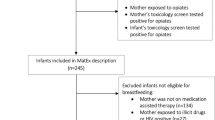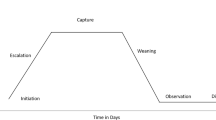Abstract
Objective
To determine if lactose-free formula, compared to lactose-containing formula, decreases the cumulative morphine dose required to treat neonatal abstinence syndrome (NAS).
Study design
In a double-blind clinical trial, we randomized 74 infants (36–42 weeks gestation) at risk for developing NAS due to in-utero exposure to opioids to receive either lactose-free (Similac Sensitive®) or lactose-containing (Similac Advance®) infant formula. The primary outcome measure was the cumulative dose of morphine used for the treatment of NAS during the first 14 days of life.
Results
Data on 69 (4 withdrew consent and 1 ineligible)/74 randomized infants were analyzed. Patient characteristics between the infant groups fed lactose-free (n = 34) vs. lactose-containing (n = 35) infant formula were similar except more common maternal heroin abuse in the latter group (p = 0.013). Cumulative morphine dose (20.7 ± 19.8 vs. 23 ± 23.5 mg, p = 0.61) between the two groups were similar.
Conclusion
Lactose-free vs. lactose-containing infant formula did not change the outcomes of infants with NAS.
This is a preview of subscription content, access via your institution
Access options
Subscribe to this journal
Receive 12 print issues and online access
$259.00 per year
only $21.58 per issue
Buy this article
- Purchase on Springer Link
- Instant access to full article PDF
Prices may be subject to local taxes which are calculated during checkout

Similar content being viewed by others
References
Patrick SW, Schumacher RE, Benneyworth BD, Krans EE, McAllister JM, Davis MM. Neonatal abstinence syndrome and associated health care expenditures: United states, 2000–2009. JAMA 2012;307:1934–40. https://doi.org/10.1001/jama.2012.3951.
Patrick SW, Davis MM, Lehmann CU, Cooper WO. Increasing incidence and geographic distribution of neonatal abstinence syndrome: United states 2009 to 2012. J Perinatol 2015;35:650–5. https://doi.org/10.1038/jp.2015.36.
Ko JY, Patrick SW, Tong VT, Patel R, Lind JN, Barfield WD. Incidence of neonatal abstinence syndrome - 28 states, 1999-2013. MMWR Morb Mortal Wkly Rep. 2016;65:799–802. https://doi.org/10.15585/mmwr.mm6531a2.
Tolia VN, Patrick SW, Bennett MM, Murthy K, Sousa J, Smith PB, et al. Increasing incidence of the neonatal abstinence syndrome in U.S. neonatal ICUs. N Engl J Med. 2015;372:2118–26. https://doi.org/10.1056/NEJMsa1500439.
Oei JL, Melhuish E, Uebel H, Azzam N, Breen C, Hilder L, et al. Neonatal abstinence syndrome and high school performance. Pediatrics. 2017;139:e20162651. https://doi.org/10.1542/peds.2016-2651. Epub 16 Jan 2017.
Nygaard E, Moe V, Slinning K, Walhovd KB. Longitudinal cognitive development of children born to mothers with opioid and polysubstance use. Pediatr Res. 2015;78:330–5. https://doi.org/10.1038/pr.2015.95.
Hudak ML, Tan RC. Committee on drugs, committee on fetus and newborn, American Academy of Pediatrics. Neonatal drug withdrawal. Pediatrics. 2012;129:e540–60. https://doi.org/10.1542/peds.2011-3212.
Walsh MC, Crowley M, Wexelblatt S, Ford S, Kuhnell P, Kaplan HC, et al. Ohio perinatal quality collaborative improves care of neonatal narcotic abstinence syndrome. Pediatrics. 2018;141:e20170900. https://doi.org/10.1542/peds.2017-0900. Epub 7 Mar 2018.
Velez M, Jansson M. The opioid dependent mother and newborn dyad: nonpharmacologic care. J Addiction Med. 2008;2:113–20. https://doi.org/10.1097/ADM.0b013e31817e6105.
Alsaleem M, Berkelhamer S, Wilding G, Miller L, Reynolds A. Effects of partially hydrolyzed formula on severity and outcomes of neonatal abstinence syndrome. 2019. https://doi.org/10.1055/s-0039-1692684.
Bogen DL, Hanusa BH, Baker R, Medoff-Cooper B, Cohlan B. Randomized clinical trial of standard- versus high-calorie formula for methadone-exposed infants: a feasibility study. Hosp Pediatr. 2018;8:7. https://doi.org/10.1542/hpeds.2017-0114.
Bogen DL, Whalen BL, Kair LR, Vining M, King BA. Wide variation found in care of opioid-exposed newborns. Acad Pediatr. 2017;17:374–80. https://doi.org/10.1016/j.acap.2016.10.003.
Wilson-Costello D, Walsh MC, Langer JC, Guillet R, Laptook AR, Stoll BJ, et al. Impact of postnatal corticosteroid use on neurodevelopment at 18 to 22 months’ adjusted age: effects of dose, timing, and risk of bronchopulmonary dysplasia in extremely low birth weight infants. Pediatrics 2009;123:e430–7. https://doi.org/10.1542/peds.2008-1928.
Ballard O, Morrow AL. Human milk composition: nutrients and bioactive factors. Pediatr Clin North Am. 2013;60:49. https://doi.org/10.1016/j.pcl.2012.10.002.
Belamarich PF, Bochner RE, Racine AD. A critical review of the marketing claims of infant formula products in the united states. Clin Pediatr. 2016;55:437–42. https://doi.org/10.1177/0009922815589913.
Abrams SA, Griffin IJ, Davila PM, Abrams SA. Calcium and zinc absorption from lactose-containing and lactose-free infant formulas. Am J Clin Nutr. 2002;76:442–6. https://doi.org/10.1093/ajcn/76.2.442.
Cederlund A, Kai-Larsen Y, Printz G, Yoshio H, Alvelius G, Lagerkrantz H, et al. Lactose in human breast milk an inducer of innate immunity with implications for a role in intestinal homeostasis. PLoS ONE. 2013;8. https://doi.org/10.1371/journal.pone.0053876.
Kinouchi T, Koyama S, Harada E, Yajima T, Kinouchi T. Large molecule protein feeding during the suckling period is required for the development of pancreatic digestive functions in rats. Am J Physiol Regul, Integr Comp Physiol. 2012;303:R1268–76. https://doi.org/10.1152/ajpregu.00064.2012.
Academy of Breastfeeding Medicine Protocol Committee, Jansson LM. ABM clinical protocol #21: guidelines for breastfeeding and the drug-dependent woman. Breastfeed Med. 2009;4:225–8. https://doi.org/10.1089/bfm.2009.9987.
Hicks J, Morse E, Wyant DK. Barriers and facilitators of breastfeeding reported by postpartum women in methadone maintenance therapy. Breastfeed Med. 2018;13:259–65. https://doi.org/10.1089/bfm.2017.0130.
Kendall-Tackett K. Violence against women and the perinatal period: the impact of lifetime violence and abuse on pregnancy, postpartum, and breastfeeding. Trauma, Violence, Abus. 2007;8:344–53. https://doi.org/10.1177/1524838007304406.
Jansson LM, Choo R, Velez ML, Lowe R, Huestis MA, Jansson LM. Methadone maintenance and long-term lactation. Breastfeed Med: Off J Acad Breastfeed Med. 2008;3:34–37. https://doi.org/10.1089/bfm.2007.0032.
Isemann B, Meinzen-Derr J, Akinbi H. Maternal and neonatal factors impacting response to methadone therapy in infants treated for neonatal abstinence syndrome. J Perinatol. 2011;31:25–29. https://doi.org/10.1038/jp.2010.66.
Welle-Strand GK. Breastfeeding reduces the need for withdrawal treatment in opioid-exposed infants. Acta Pædiatrica (Oslo) 2013;102:1060–6.
Begg EJ, Malpas TJ, Hackett LP, Ilett KF. Distribution of R- and S-methadone into human milk during multiple, medium to high oral dosing. Br J Clin Pharmacol. 2001;52:681. https://doi.org/10.1046/j.0306-5251.2001.01506.x.
Lindemalm S, Nydert P, Svensson J, Stahle L, Sarman I. Transfer of buprenorphine into breast milk and calculation of infant drug dose. J Hum Lactation 2009;25:199–205. https://doi.org/10.1177/0890334408328295.
Ilett KF, Hackett LP, Gower S, Doherty DA, Hamilton D, Bartu AE. Estimated dose exposure of the neonate to buprenorphine and its metabolite norbuprenorphine via breastmilk during maternal buprenorphine substitution treatment. (report). Breastfeed Med. 2012;7:269.
Gray L, Miller LW, Philipp BL, Blass EM. Breastfeeding is analgesic in healthy newborns. Pediatrics 2002;109:590. https://doi.org/10.1542/peds.109.4.590.
Shah PS, Aliwalas L, Shah V, Shah PS. Breastfeeding or breastmilk to alleviate procedural pain in neonates: a systematic review. Breastfeed Med: Off J Acad Breastfeed Med. 2007;2:74–82. https://doi.org/10.1089/bfm.2006.0031.
Mian P, Tibboel D, Wildschut ED, van Den Anker J, Allegaert K, Mian P. Morphine treatment for neonatal abstinence syndrome: Huge dosing variability underscores the need for a better clinical study design. Minerva Pediatr. 2019;71:263–86. https://doi.org/10.23736/S0026-4946.17.04928-3.
Surran B, Visintainer P, Chamberlain S, Kopcza K, Shah B, Singh R. Efficacy of clonidine versus phenobarbital in reducing neonatal morphine sulfate therapy days for neonatal abstinence syndrome. A prospective randomized clinical trial. J Perinatol 2013;33:954. https://doi.org/10.1038/jp.2013.95.
Chisamore B, Labana S, Blitz S, Ordean A, Chisamore B. A comparison of morphine delivery in neonatal opioid withdrawal. Subst Abuse: Res Treat 2016;10:49–54.
Gordon AL, Lopatko OV, Haslam RR, Stacey H, Pearson V, Woods A, et al. Ineffective morphine treatment regimen for the control of neonatal abstinence syndrome in buprenorphine- and methadone-exposed infants. J Dev Orig Health Dis. 2012;3:262–70. https://doi.org/10.1017/S2040174412000190.
Cleary BJ, Eogan M, O’Connell MP, Fahey T, Gallagher PJ, Clarke T, et al. Methadone and perinatal outcomes: a prospective cohort study. Addiction 2012;107:1482–92. https://doi.org/10.1111/j.1360-0443.2012.03844.x.
Fielder AL, Coller JK, Hutchinson MR, Haslam RR, Lu N, Adeniyi-Jones SC, et al. Neonatal abstinence syndrome in methadone exposed infants: role of genetic variability. Drug Alcohol Depend. 2015;146:e277. https://doi.org/10.1016/j.drugalcdep.2014.09.219.
Grossman MR, Berkwitt AK, Osborn RR, Xu Y, Esserman DA, Shapiro ED, et al. An initiative to improve the quality of care of infants with neonatal abstinence syndrome. Pediatrics 2017;139:e20163360.
Blount T, Painter A, Freeman E, Grossman M, Sutton AG. Reduction in length of stay and morphine use for NAS with the “Eat, Sleep, Console” method. Hospital Pediatr. 2019;9:615–23.
Tortu S, McMahon JM, Pouget ER, Hamid R. Sharing of noninjection drug-use implements as a risk factor for hepatitis C. Subst Use Misuse 2004;39:211–24.
Fronstin P. Mental health, substance abuse, and pregnancy: health spending following the PPACA adult-dependent mandate. EBRI Issue Brief 2013;385:4–14.
Acknowledgements
The authors thank all the parents of participating infants, nursing, and medical staff in L&D, newborn nursery, and the NICU.
Author information
Authors and Affiliations
Contributions
RP, NK, MI researched, designed the study, recruited patients, contributed to data interpretation, read and edited the paper. NS recruited patients, read and edited the paper. DS designed the study, analyzed and interpreted the data, and edited the paper. SGW researched, designed the study, contributed to data interpretation, and edited the paper. DK researched, designed the study, contributed to data analysis and interpretation, wrote and edited the paper. RP, NK, MI, NS, DS, SGW, DK read, edited, and approved the final version of the paper. DK is the guarantor of this work and had full access to all the data in the study and takes responsibility for the integrity of the data and the accuracy of the data analysis.
Corresponding author
Ethics declarations
Conflict of interest
The authors declare that they have no conflict of interest.
Additional information
Publisher’s note Springer Nature remains neutral with regard to jurisdictional claims in published maps and institutional affiliations.
Rights and permissions
About this article
Cite this article
Pandey, R., Kanike, N., Ibrahim, M. et al. Lactose-free infant formula does not change outcomes of neonatal abstinence syndrome (NAS): a randomized clinical trial. J Perinatol 41, 598–605 (2021). https://doi.org/10.1038/s41372-020-00797-7
Received:
Revised:
Accepted:
Published:
Issue Date:
DOI: https://doi.org/10.1038/s41372-020-00797-7
This article is cited by
-
Neonatal abstinence syndrome and mother’s own milk at discharge
Journal of Perinatology (2022)



